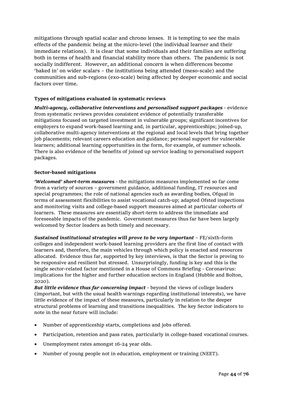
Page 44 of 76
mitigations through spatial scalar and chrono lenses. It is tempting to see the main
effects of the pandemic being at the micro-level (the individual learner and their
immediate relations). It is clear that some individuals and their families are suffering
both in terms of health and financial stability more than others. The pandemic is not
socially indifferent. However, an additional concern is when differences become
'baked in' on wider scalars - the institutions being attended (meso-scale) and the
communities and sub-regions (exo-scale) being affected by deeper economic and social
factors over time.
Types of mitigations evaluated in systematic reviews
Multi-agency, collaborative interventions and personalised support packages - evidence
from systematic reviews provides consistent evidence of potentially transferable
mitigations focused on targeted investment in vulnerable groups; significant incentives for
employers to expand work-based learning and, in particular, apprenticeships; joined-up,
collaborative multi-agency interventions at the regional and local levels that bring together
job placements; relevant careers education and guidance; personal support for vulnerable
learners; additional learning opportunities in the form, for example, of summer schools.
There is also evidence of the benefits of joined up service leading to personalised support
packages.
Sector-based mitigations
'Welcomed' short-term measures - the mitigations measures implemented so far come
from a variety of sources - government guidance, additional funding, IT resources and
special programmes; the role of national agencies such as awarding bodies, Ofqual in
terms of assessment flexibilities to assist vocational catch-up; adapted Ofsted inspections
and monitoring visits and college-based support measures aimed at particular cohorts of
learners. These measures are essentially short-term to address the immediate and
foreseeable impacts of the pandemic. Government measures thus far have been largely
welcomed by Sector leaders as both timely and necessary.
Sustained institutional strategies will prove to be very important - FE/sixth-form
colleges and independent work-based learning providers are the first line of contact with
learners and, therefore, the main vehicles through which policy is enacted and resources
allocated. Evidence thus far, supported by key interviews, is that the Sector is proving to
be responsive and resilient but stressed. Unsurprisingly, funding is key and this is the
single sector-related factor mentioned in a House of Commons Briefing - Coronavirus:
implications for the higher and further education sectors in England (Hubble and Bolton,
2020).
But little evidence thus far concerning impact - beyond the views of college leaders
(important, but with the usual health warnings regarding institutional interests), we have
little evidence of the impact of these measures, particularly in relation to the deeper
structural problems of learning and transitions inequalities. The key Sector indicators to
note in the near future will include:
• Number of apprenticeship starts, completions and jobs offered.
• Participation, retention and pass rates, particularly in college-based vocational courses.
• Unemployment rates amongst 16-24 year olds.
• Number of young people not in education, employment or training (NEET).